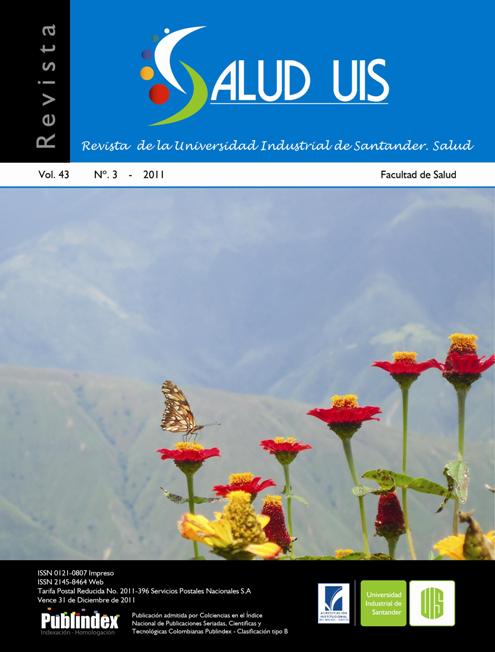Resumen
RESUMEN
Introducción: Es posible evitar muertes neonatales mediante la lactancia materna desde el primer día devida, pues la leche materna es el alimento óptimo para el lactante por su contenido nutricional necesariofavorecer el crecimiento y desarrollo. Objetivo: Determinar la prevalencia y factores asociados aldiagnóstico de enfermería “Lactancia materna ineficaz” en lactantes menores de 6 meses hospitalizados enuna institución de tercer nivel.
Metodología: Estudio de corte transversal. Se seleccionaron 108 binomios(madre e hijo) hospitalizados en una institución de tercer nivel de atención en el año 2009, se aplicó unformato validado para identificar el diagnóstico. Se realizó análisis Rasch a las variables que representanlas características definitorias del diagnóstico, con el cual se creó una escala de 0 a 100 y se construyóun modelo de regresión lineal con las variables asociadas a la medida del diagnóstico.
Resultados:la prevalencia del diagnóstico fue de 93,5 %, la característica definitoria más fácil de encontrar fueIncapacidad del lactante para agarrarse al pecho materno y la más difícil fue agitación y llanto del lactantedentro de la primera hora después de la lactancia materna. La regresión lineal mostró factores asociadoscomo: género femenino, peso del lactante y necesidad de la madre de ir a orinar.
Conclusiones: Existeuna tendencia desfavorable tanto en la prevalencia como en la duración de la lactancia materna para loslactantes hospitalizados; la promoción de la lactancia materna debe ser un trabajo interdisciplinario;modificar las normas hospitalarias favoreciendo el contacto del binomio y la puesta temprana al pechomaterno. Salud UIS 2011; 43 (3): 271-279
Palabras clave: Lactancia materna, diagnóstico de enfermería, lactante, prevalencia,factores asociados
ABSTRACT
Introduction: neonatal deaths can be prevented by breastfeeding from the first day of life, as is the optimal foodfor infants by their nutritional content required for better growth and development.
Objective: To determine theprevalence and associated factors with nursing diagnosis “ineffective breastfeeding” in infants under than 6 monthshospitalized in a tertiary institution.
Methodology: Cross sectional study. We selected 108 pairs (mother and child)hospitalized in an institution of tertiary care in 2009, we applied a validated format to identify the diagnosis. Raschanalysis was performed for variables that represent the defining characteristics of the diagnosis, which created ascale of 0 to 100 and built a linear regression model the variables associated with the extent of diagnosis.
Results:Prevalence of diagnosis was 93,5 %, the defining characteristic was easier to find the infant’s inability to hold onto the breast and the hardest was shaking and crying of the infant within the first hour after breastfeeding. Linearregression was associated factors such as: female gender, weight infant and the mother need to urinate.
Conclusions:There is an unfavorable trend in both the prevalence and duration of breastfeeding for infants hospitalized, promotionof breastfeeding should be an interdisciplinary, modify hospital policies favoring the contact of the binomial and theearly start to the chest maternal. Salud UIS 2011; 43 (3): 271-279
Keywords: Breastfeeding, nursing diagnosis, infant, prevalence, associated factors
Se autoriza la reproducción total o parcial de la obra para fines educativos, siempre y cuando se cite la fuente.
Esta obra está bajo una Licencia Creative Commons Atribución 4.0 Pública Internacional.
